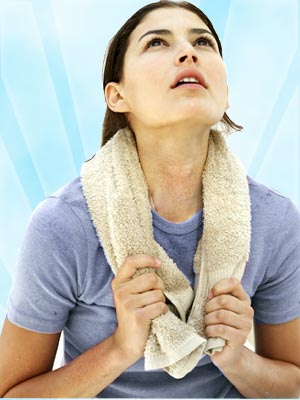Prickly Heat

Summer is the time for outdoor activities, lazing on the beach, picnics and more. But beware of Prickly heat rash - painful fallout of hot and humid summers. This uncomfortable condition is more common among children though adults experience it too. Caused by excessive perspiration, prickly heat can be kept at bay with simple steps.
Prickly heat and rash
In medical parlance, prickly heat is referred to as miliaria - a common condition that occurs when you are in a hot and humid place. Excessive perspiration wreaks damage on the outer surface of the skin. The damaged cells form a barrier and sweat gets entrapped beneath the skin. This moisture manifests as small red rashes or eruptions. They cause a stinging prickling feeling. The red eruptions arise as a result of blood vessels in the area dilating to cool the skin down.
Such bumps erupt on covered parts of the skin, where there is friction with cloth. Typically prickly heat rash appears on the forehead, upper back and chest and arms. Prickly heat is not just uncomfortable; it is a sign that the body is not reacting well to heat stress. Consequently, a person prickly heat is at greater risk for heat stroke. Cooling the skin usually makes prickly heat rash disappear. It often causes itching and gets aggravated on the use of oils and ointments.
Small babies and children and the elderly are at risk of prickly heat. So are those in sports or other forms of exercise or manual labor. While prickly heat normally goes in a few days, it can last for weeks if it is hot and humid. A combination of preventative measures and immediate treatment ensure quick recovery.
Prevent prickly heat rash
- Keep the affected area cool and dry
- In summer, avoid lotions and cosmetics that are oil-based as they will create a warm and moist environment
- Stay cool. Do not use antiperspirant lotions or deodorants on the prickly heat rashes
- Wear loose-fitting clothes in extremely warm and humid weather to promote better evaporation of perspiration
- Keep out of direct sunlight
- Maintain good hydration by drinking plenty of water and other fluids
- Ensure good rest if you are engaged in physical exertion during the hot day
- Be well protected against direct sunlight with sunscreen, hat and protective clothes
- In very hot and humid weather, you can avoid saturated fats and foods with high acidity levels. You can consume fish, fresh fruits and vegetables.
- Antihistamines are helpful to control itching. Alcohol-based lotions can provide some relief.
- Vitamin C may reduce itching and inflammation.
Natural remedies for the rash
Keeping your body cool is vital during hot harsh summers. Drink plenty of water throughout the day. Cool fresh fruits like watermelon, lemon and musk melons are ideal to snack on. Drink tender coconut water, khus sherbets and barley water. You can apply rose water, aloe vera gel or sandalwood paste to the skin.
Top of the Page: Prickly Heat
Tags:#prickly heat #prickly heat rash
Stress Hives - Red itchy spots ...
Vitiligo Skin Disease - De-pigmented patches ...
Prickly Heat - Painful fallout of hot and humid summers ...
Narrow Band UVB - Used for skin conditions ...
Photodynamic Therapy - Combination of light and photosensitizing drugs ...
Mold Allergy - Reacting to mold spores ...
Latex Allergy - Reactions to soluble proteins in latex ...
Skin Fungus Infection - Itching and soreness ...
Eczema Treatment - Red, flaky skin, cracks or tiny blisters ...
Varicose Veins - Veins swell and rise above the level of the skin ...
Other health topics in TargetWoman Women Health section:
General Women Health

Women Health Tips - Women Health - key to understanding your health ...
Cardiac Care
Women's Heart Attack Symptoms - Identify heart problems...
Skin Diseases
Stress Hives - Red itchy spots ...
Women Disorders
Endocrine Disorder - Play a key role in overall wellbeing ...
Women's Reproductive Health
Testosterone Cream for Women - Hormone replacement option ...
Pregnancy
Pregnancy - Regulate your lifestyle to accommodate the needs of pregnancy ...
Head and Face
Sinus Infection - Nearly 1 of every 7 Americans suffer from ....
Women and Bone Care

Slipped Disc - Prevent injury, reduce pain ...
Menstrual Disorders
Enlarged Uterus - Uterus larger than normal size ...
Female Urinary Problems
Bladder Problems in Women - Treatable and curable ...
Gastrointestinal Disorders
Causes of Stomach Ulcers - Burning feeling in the gut ...
Respiratory Disorders
Lung function Test - How well do you breathe ...
Sleep Management

Insomnia and Weight Gain - Sleep it off ...
Psychological Disorders in Women
Mood swings and women - Not going crazy ...
Supplements for Women
Women's Vitamins - Wellness needs...
Natural Remedies

Natural Diuretic - Flush out toxins ...
Alternative Therapy
Acupuncture Point - Feel the pins and needles ...
Top of the Page: Prickly Heat
Popularity Index: 100,755

